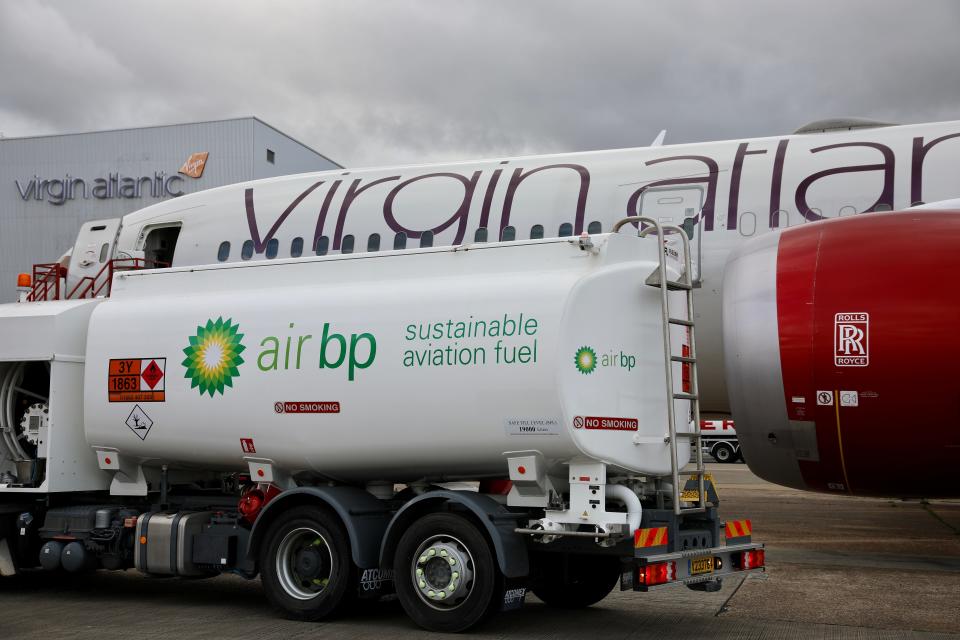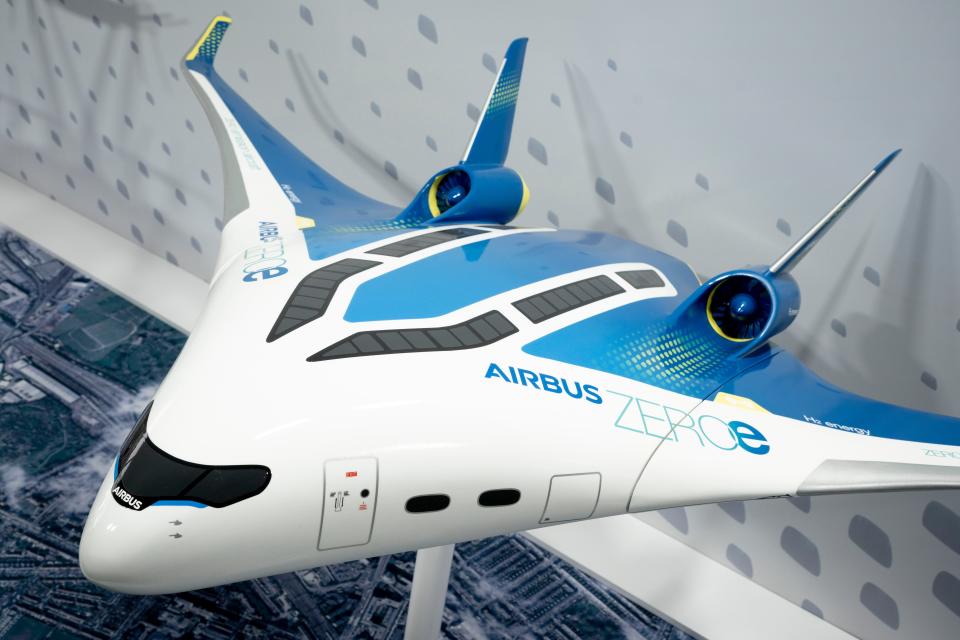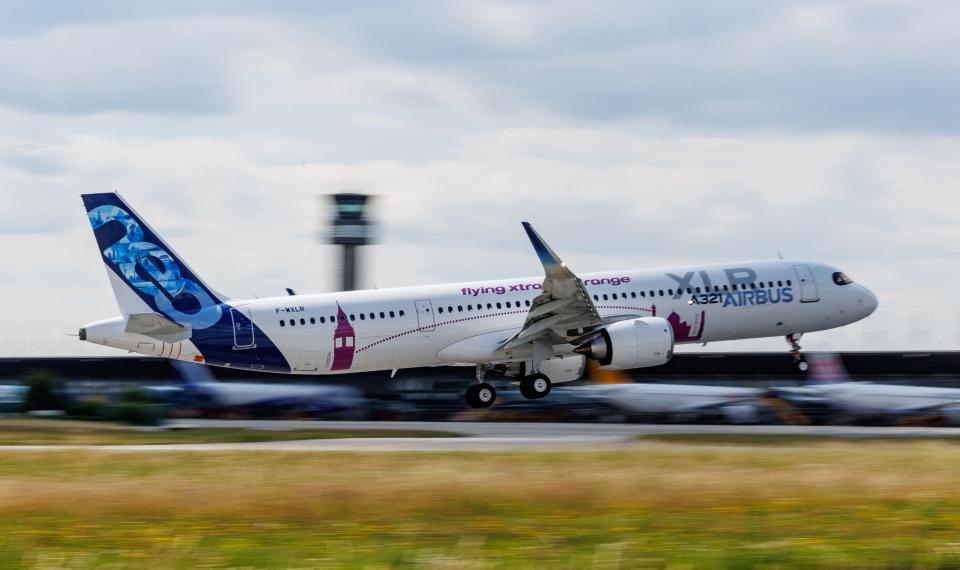The aviation industry wants to reach net zero by 2050, but major players disagree on how to get there
The aviation industry says it's committed to achieving net-zero emissions by 2050.
But there are different ways to get there, such as the "carrot-and-stick" approach.
Airbus' chief sustainability officer told BI why it's betting on hydrogen and fleet renewal.
This article is part of "Future of Sustainable Aerospace," a series exploring the industry's green trends.
In late November, Virgin Atlantic operated the world's first transatlantic flight on a commercial airliner powered by sustainable aviation fuel, or SAF.
The Boeing 787 Dreamliner touched down at JFK Airport in New York City about seven hours after leaving London's Heathrow Airport, marking the latest development toward reaching the aviation industry's goal of net-zero emissions by 2050.
The International Air Transport Association, or IATA, estimated that SAF can reduce CO2 emissions by up to 80%.
According to the International Energy Agency, aviation accounts for about 2% of global CO2 emissions. The Guardian reported that a flight from London to New York generates about 986 kilograms of CO2 per passenger. It would take the average American 27 days to emit that much CO2, according to data from the World Bank.
With an average of 45,000 daily flights in the US alone, it's no wonder that almost every major airline and manufacturer has committed to reaching net-zero CO2 emissions by 2050.
But debates are still ongoing as to how airlines can achieve this and which technologies will be most impactful.
The carrot versus the stick in sustainable aviation
SAF was a major topic of discussion when Business Insider visited the Dubai Airshow last month.
One phrase that kept popping up in conversations was "carrots versus sticks" — whether fiscal incentives or legal mandates are better at promoting SAF.
In Europe, there's a preference for mandates. The European Union is lobbying for an international tax on traditional jet fuels rather than SAF at COP 28 climate-crisis conference, the Financial Times reported. But that money isn't guaranteed to be reinvested into sustainable aviation.
And from 2025, the RefuelEU Aviation initiative mandates aircraft fuel suppliers to provide EU airports with a minimum share of 2% SAF, increasing to 75% by 2050. Airlines will also be prohibited from deliberately carrying excess fuel to avoid refueling with SAF.
This ups demand, but doesn't necessarily advance SAF production. The EU's Aviation Safety Agency says the maximum potential SAF production in the bloc is currently only 10% of what's needed to fulfill proposed mandates by 2030.
According to the IATA, SAF is twice as expensive as conventional aviation fuel.
The US prefers the incentive, or the carrot: This strategy can stimulate more growth by rewarding SAF producers but lacks longevity and could come crashing down with a change in administration.

Most airshow panelists strongly favored the carrot and loathed the stick.
Some rare positivity about mandates came from Julie Kitcher, an executive vice president at Airbus who will take on the role of chief sustainability officer at the company starting January 1.
"I'm a big fan of both," she told Business Insider. "We're a big advocate of having mandates and incentives to be able to stimulate the supply and demand."
She said "we've really got to break that vicious cycle" of the limited supply and high demand that leads to high prices.
Different perspectives at Airbus and Boeing
"We have to have SAF to get us to net zero, but there's questions about what else," Jim Hileman, the vice president and chief engineer for sustainability at Boeing, said during a panel. "Are there other things that we should be pursuing?"
One major project at Airbus is ZEROe. It's focused on developing hydrogen-powered aircraft that the company hopes to put to market by 2035.
Hydrogen doesn't emit carbon like fossil fuels do, but it also relies on new infrastructure. Kitcher told BI that such airplanes will require airports to store liquid hydrogen for fueling, which needs to be kept at -400 degrees Fahrenheit.
Boeing isn't focusing much on hydrogen and seems skeptical of Airbus' hopes.
While onstage at the Dubai Airshow, Hileman posited a host of questions about hydrogen-powered aircraft: "Can you safely operate the aircraft? What does the infrastructure look like? By the way, there better be a value proposition at the end."

It sounds like a lot of hurdles to overcome. But Kitcher told BI that Airbus sees it as a "lot of opportunities to develop technology."
She acknowledged that "we're not going to fly transatlantic on hydrogen anytime soon." But said the project will show "technological readiness" that can scale in the future.
Boeing's sustainable-aircraft innovations include Wisk Aero, an eVTOL, or electric vertical-takeoff-and-landing, company; and the X-66A, a plane it's working on in collaboration with NASA that's only expected to reduce fuel consumption by up to 30%.
Newer airplanes are more fuel-efficient
Kitcher told BI that as well as working on new technologies and transitioning to new energy sources, fleet renewal can have a big impact on climate goals.
When a plane reaches the end of its lifespan, the airline replaces it with a newer, more fuel-efficient model — typically from Boeing or Airbus.

The Airbus A321XLR — set to enter service in 2024 — is a narrow-body jet capable of flying up to 11 hours nonstop, opening up new routes that would be uneconomical if carriers used wide-body jets.
According to Kitcher, replacing a Boeing 737 with an Airbus A321XLR would reduce CO2 emissions by 25%.
"So it's a pretty impressive lever, particularly when you consider that today only 25% of the world's fleet is flying on latest-generation technology," she told BI.
Boeing says that its newer 737 MAX models can reduce CO2 emissions by 20% compared to predecessors.
There are several different routes and myriad technologies companies are using to achieve net-zero emissions by 2050. Which bets are the most impactful may not be obvious for another few years.
Read the original article on Business Insider

